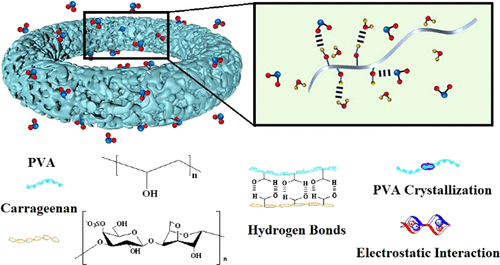Our official English website, www.x-mol.net, welcomes your
feedback! (Note: you will need to create a separate account there.)
Hydrogel-Based Gas Sensors for NO2 and NH3.
ACS Sensors ( IF 8.2 ) Pub Date : 2020-02-21 , DOI: 10.1021/acssensors.9b02383 Hui Zhi 1, 2 , Jianmei Gao 1, 2 , Liang Feng 1
ACS Sensors ( IF 8.2 ) Pub Date : 2020-02-21 , DOI: 10.1021/acssensors.9b02383 Hui Zhi 1, 2 , Jianmei Gao 1, 2 , Liang Feng 1
Affiliation

|
In this study, an innovative gas sensing mechanism, self-responsive sensing mechanism, has been detected in the supramolecular hydrogel-based sensors. The self-responsive ability of as-fabricated hydrogel-based sensors to the target gas (e.g., NO2, NH3, etc.) is determined by three synergetic supramolecular interactions, namely, hydrogen bonding, molecule crystallization, and electrostatic interactions existing in hydroxyls, poly(vinyl alcohol) (PVA) crystallization, and poly(ionic liquids) of the intrinsic hydrogel networks, respectively. On account of unique synergetic supramolecular interactions, the sensors not only exhibit a rapid, reversible, and reproducible response but also show good tensile and compressive properties and excellent recovery property. The results demonstrate the potential of the self-responsive sensing mechanism as a pathway to realize a new generation of highly responsive hydrogel-based gas sensors.
中文翻译:

基于水凝胶的NO2和NH3气体传感器。
在这项研究中,已经在基于超分子水凝胶的传感器中检测到一种创新的气体传感机制,即自响应传感机制。预制的基于水凝胶的传感器对目标气体(例如,NO2,NH3等)的自我响应能力由氢的三个超分子相互作用确定,即氢键,分子结晶和羟基中存在的静电相互作用,聚乙烯醇(PVA)结晶和固有水凝胶网络的聚(离子液体)。由于独特的协同超分子相互作用,这些传感器不仅显示出快速,可逆和可再现的响应,而且还显示出良好的拉伸和压缩特性以及出色的恢复特性。
更新日期:2020-02-21
中文翻译:

基于水凝胶的NO2和NH3气体传感器。
在这项研究中,已经在基于超分子水凝胶的传感器中检测到一种创新的气体传感机制,即自响应传感机制。预制的基于水凝胶的传感器对目标气体(例如,NO2,NH3等)的自我响应能力由氢的三个超分子相互作用确定,即氢键,分子结晶和羟基中存在的静电相互作用,聚乙烯醇(PVA)结晶和固有水凝胶网络的聚(离子液体)。由于独特的协同超分子相互作用,这些传感器不仅显示出快速,可逆和可再现的响应,而且还显示出良好的拉伸和压缩特性以及出色的恢复特性。











































 京公网安备 11010802027423号
京公网安备 11010802027423号